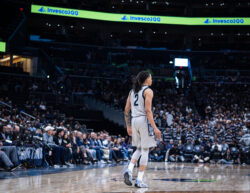In an increasingly forgiving sports world, where people like Pete Rose are championed by many for the Hall of Fame and others like Ricky Williams are welcomed back to their team after turning their backs on their fellow players, a change of heart is easier to come by than it used to be. Beliefs, values and morals span the spectrum of public opinion, but influencing the thoughts of sports fans across the country are coaxed by constant bombardments of images and commentary on 24-hour sports television networks.
With the debut of his new series, “Bonds on Bonds,” San Francisco Giants’ slugger Barry Bonds has taken a completely new and radical approach to combating allegations of his steroid use. Arguably the most galvanizing figure in sports, not for what he says, but for what he doesn’t, Bonds had never let anyone into his inner circle. The most people know about him is what they hear from everyone else—their friends, family and sixth-grade gym teacher. But the funny thing is that no one knows the truth.
Now Bonds is trying to rid himself of the clubhouse-recliner-sitting, entourage-leading, selfish player that most of the country sees. Through the hour-long weekly show, Bonds gives the world seemingly unlimited access. For most of the last couple of years all lights and cameras have been glued on Bonds, but he has had no control over what they produce. Now, for a 60-minute period each week, the camera is focused on Bonds the way Bonds wants to be seen: human.
In the debut episode Bonds talks extensively in comfortable surroundings about his career, his father’s death, his childhood and most importantly about recent allegations of being a juicer. Instead of being the normally defiant superstar we have known him to be, Bonds allows people to take a step back and attempt to see him as he really is.
Shots of Bonds visiting his father’s grave and crying under the weight of racial hate mail and numerous allegations had to have struck some sort of cord with every person who watched. He even talked about how his teammates depend on him to work hard and be on the field as much as he can; a far cry from anything anyone would have woven into an Outside the Lines special on Bonds.
With former Senate Majority Leader George Mitchell heading a probe into alleged steroid use in baseball (read: probe into Bonds) the heat is rising on one of the most productive players ever. But unless that probe yields a positive test for Bonds, accusations mean nothing. If there’s no positive test from when Major League Baseball first began its testing program he wouldn’t continue using now that the program has already nabbed a few players. The battle will continue to be waged in the court of public opinion and by opening up to the world Bonds has inevitably drawn some people who were riding the fence over to his side.
A 41-year-old man, with a bad right knee and six homers behind Babe Ruth, has finally attempted to win the biggest game of his life, the game dealing with his legend. Bonds has repeatedly said he does not care what people write or say about him, but this series proves exactly the opposite. Bonds does care—he may be breaking under the pressure. But this new tactic, one that took him 20 years in the majors to discover, might just prove to be the thing Bonds needs to save his legacy. It’s worth a shot.




